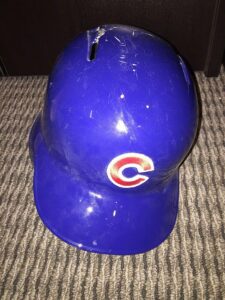Welcome to our blog post, where we delve into an important question that often lingers in the minds of baseball enthusiasts and players alike: “Do baseball helmets expire?” As we all know, safety is the most important aspect of any sport, and understanding the lifespan of protective equipment is fundamental. In this informative post, we will look at the variables that lead to baseball helmet expiry, the signals that indicate a helmet’s retirement, and the need for regular checks. So, take your favorite bat and prepare to learn the truth about the longevity of these important pieces of equipment in America’s favorite game.
Do baseball helmets expire?
Yes, baseball helmets do expire, but it’s not a sudden expiration. When you purchase a helmet, you are aware that it will be good for a specific period, typically around five years. Over time, the materials used in the helmet may degrade, compromising their ability to provide adequate protection. Factors such as wear and tear, exposure to sunlight, and impacts can accelerate this deterioration. To ensure optimal safety, it is recommended to replace the helmet once it reaches its expiration date or if any damage or cracks are detected. Regular inspection and maintenance of helmets are crucial to safeguarding players on the baseball field.
Factors Affecting Lifespan of Baseball Helmet
Baseball helmets are built to endure the game’s rigors, but various factors may decrease their lifespan. Players may ensure that their helmets provide adequate protection by considering all of these factors.

1. Material and Construction:
Baseball helmet materials vary, but most helmets have a hard outer shell and a cushioned inner. High-quality helmets frequently include long-lasting materials such as ABS plastic, polycarbonate, or carbon fiber, which improves their capacity to withstand attacks. Furthermore, the helmet’s structure, such as reinforced seams and robust bonding, might help its longevity.
2. Use Frequency and Intensity:
The more often a helmet is used, the more wear and tear it will sustain. Regular practices, games, and even unintentional drops can eventually weaken the protective features of a helmet. Furthermore, high-impact accidents, like getting hit by a thrown ball, can increase stress on the helmet and potentially compromise its integrity.
3. Maintenance and Care:
Proper maintenance and care help to enhance the lifespan of a baseball helmet. Regular cleaning to eliminate dirt and sweating build-up maintains the helmet hygienic and avoids material degradation. It’s also a good idea to look for signs of damage on the helmet, such as cracks, dents, or loose padding. If any problems are discovered, they should be repaired or replaced as soon as possible.
While manufacturers do not normally specify exact expiry dates for baseball helmets, it is critical to routinely examine their condition. As a general rule, if a helmet exhibits evidence of considerable wear and tear or damage or no longer fits well, it should be replaced.
Do Baseball Helmets Have an Expiration Date?
Expiration dates for baseball helmets are sometimes misinterpreted. Baseball helmets do not have manufacturer-specified expiration dates, unlike some perishable products, such as food. Instead, their longevity is determined by various criteria, including their usage, condition, and industry guidelines.
It is critical to clarify the myth that helmets expire after a specific time. While helmets do not have an expiration date, they can degrade over time due to wear and tear or exposure to environmental factors. As a result, it is vital to assess their health regularly and replace them as needed.
Read: Baseball Gloves for Left Handed Throwers
To ensure the continuing safety of players, the following principles should be followed:
1. Regular Evaluation:
Frequently inspect the helmet for evident indications of deterioration, such as cracks, dents, or loose padding. Inspect the general structural integrity of the helmet, including the straps, faceguards, and fasteners.
2. Industry recommendations:
Stay current on the latest industry standards and guidelines for helmet safety. Manufacturers and sports organizations frequently provide guidelines on when to replace helmets based on usage and condition.
3. Impact Assessment:
Consider the strength and frequency of impacts on the helmet. If the helmet has been in a high-impact collapse, it should be replaced since it may have suffered internal damage that limits its protective properties.
4. Aging and Environmental Factors:
Remember that even if a helmet looks in good shape, age and exposure to external conditions can compromise its integrity. UV radiation from sunshine and severe temperatures can cause the degradation of materials over time.
Players may prioritize their safety on the field by realizing that baseball helmets do not have fixed expiration dates. Instead, they require frequent review and replacement depending on wear and tear, impact assessment, industry guidelines, and environmental conditions. Remember that a well-maintained and up-to-date helmet is an important investment in preventing head injuries during the game.
When to Replace Baseball Helmets

Knowing when to change a baseball helmet is critical for player safety. While helmets do not have clear expiration dates, some principles and signs can assist in identifying when a replacement is required. By remaining vigilant and proactive, players can ensure that they are always wearing dependable and safe helmets.
1. Noticeable Wear and Tear:
Inspect your helmet regularly for visible indications of wear and tear. Examine the helmet for cracks, dents, or other structural problems that could compromise its integrity. If the helmet has severe damage or no longer looks solid, it is time to replace it.
2. Age and Usage:
Consider the helmet’s age and the frequency with which it has been used. Even with sufficient maintenance, helmets can degrade in material and lose their protective properties over time. If your helmet has been used for several years or has been damaged in high-impact events, it may be time to replace it.
3. Fit Changes:
A correctly fitting helmet is essential for efficient protection. If your helmet no longer fits snugly or is difficult to adjust correctly, it’s time to replace it. A too-big or too-small helmet may not offer enough cushioning and stability during an accident.
4. Manufacturer Suggestions:
Keep current on manufacturer recommendations for helmet replacement. While manufacturers may not disclose explicit expiry dates, they frequently provide suggestions based on their product’s estimated lifespan and safety regulations. To provide the best protection, it is essential to follow these instructions.
- Certification Requirements: Consider the certification criteria established by regulatory authorities and sports organizations, which develop over time to reflect the most recent safety improvements. If your helmet does not satisfy current certification criteria, replacing it with a newer model is best.
Remember that player safety should always be a primary priority. Examine the state of your helmet regularly, taking into account its age and usage and staying up to date on industry standards.
Read: Hat Rack for Baseball Caps
FAQs:
Q: Do baseball helmets have expiration dates?
A: Manufacturers do not specify exact expiration dates for baseball helmets. Their longevity, however, can be influenced by various circumstances, such as wear and tear, damage, and changes in safety requirements.
Q: How do you tell if a helmet is expired?
A: While baseball helmets do not have stated expiration dates, there are warning signals that it is time to replace them. Examine the helmet for obvious indications of wear, such as cracks, dents, or loose padding. Consider the helmet’s age, changes in fit, and compliance with current safety requirements.
Q: Is a 10-year-old helmet still good?
A: The age of a baseball helmet can affect its efficiency and protection. While a helmet may appear in good condition after a decade, material deterioration may have compromised its capacity to absorb impacts properly. Even if they appear to be in good shape, it is suggested that helmets that are ten years old or older be replaced.
Conclusion:
Finally, knowing baseball helmets’ lifespan and proper maintenance is important for assuring player safety on the field. While baseball helmets do not have expiration dates, various variables contribute to their deterioration over time. Players may increase the lifespan of their helmets by considering material and construction, frequency and intensity of usage, and suitable maintenance and care.

